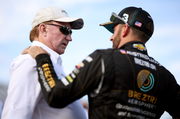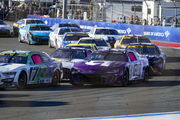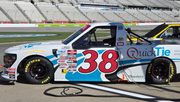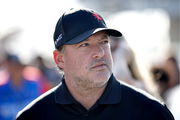
USA Today via Reuters
Sep 16, 2023; Bristol, Tennessee, USA; NASCAR Cup Series driver William Byron (24) and driver Martin Truex Jr. (19) and driver Alex Bowman (48) during the Bass Pro Shops Night Race at Bristol Motor Speedway. Mandatory Credit: Randy Sartin-USA TODAY Sports

USA Today via Reuters
Sep 16, 2023; Bristol, Tennessee, USA; NASCAR Cup Series driver William Byron (24) and driver Martin Truex Jr. (19) and driver Alex Bowman (48) during the Bass Pro Shops Night Race at Bristol Motor Speedway. Mandatory Credit: Randy Sartin-USA TODAY Sports
For decades, Bristol Motor Speedway wasn’t just another stop on the NASCAR calendar, it was the coliseum. Kyle Busch was so impeccable at the track that he was nicknamed the ‘Bristol Dominator.’ He is the winningest driver with 8 wins here, and of course, his trophy cabinet must be looking more like a gladiator’s armory! However, this time, he finished 14th. And all credit to a pit road speeding penalty during Stage 1, which pushed him down to 21st. Fans came for the short-track chaos: bump-and-run battles, late-race paybacks, and packed grandstands erupting at every lapped car scuffle. But somewhere along the way, that magic started to fade.
While the arena still looks the same, the action inside feels a little too polite. The Next Gen car promised parity and close racing, but at Bristol, it’s dulled the edge. No major lead changes, no excitement, and minimal chaos on track! Now, NASCAR insiders are openly voicing concern about the track’s slipping thrill factor and whether the real problem lies beneath the surface.
ADVERTISEMENT
Article continues below this ad
Bristol’s lost everything that made it the Coliseum
Jordan Bianchi summed it up bluntly: “I don’t think Bristol’s been Bristol for a while.” The 2025 Food City 500 made his case without much effort. Kyle Larson absolutely dominated, leading 411 of 500 laps. There were no late-race fireworks. No bumpers, no jaw-dropping restarts. Just clean air, track position, and a race most fans barely remember a week later.
Bianchi added, “We have this image of Bristol of being this physicality, you know, anything-goes racetrack.” That reputation was built on classics like the legendary 1995 Night Race between Dale Earnhardt and Terry Labonte. But in 2025, the event lacked that raw, unpredictable edge. Even with the PJ1 traction compound laid down, it turned into a high-speed parade with none of the signature elbows-out racing.
The real issue, Bianchi noted, is navigating traffic. “The biggest problem I have is when people get in traffic.” That exact problem showed up on Sunday as leaders caught slower cars. Once Larson grabbed clean air, nobody could close the gap. Passing lapped traffic became a chore instead of an opportunity, and the race ground down to a strategy-free procession.
The car’s design is also under fire for creating parity at the cost of personality. “There is very little separation, and I don’t know how you do that. Yeah, you’re going to have maybe do something with the car,” Bianchi suggested. The Next Gen’s intended fairness often prevents faster drivers from closing gaps or moving up in traffic. At Bristol, it turned the inside groove into a conveyor belt rather than a battleground, leaving fans wanting more.
Finally, tires remain the great unknown in NASCAR’s short-track struggles. “I think still the tire is the way to figuring this out,” Bianchi said. Teams struggled to predict tire wear all weekend long. Some expected a massive fall-off; others, none at all. But, the result was another race with minimal wear, limiting pit strategy and erasing one of short track racing’s most reliable equalizers. It looks like a lot has to be put into reviving short-track racing!
Trending
What’s your perspective on:
Has Bristol lost its edge, or is the Next Gen car to blame for the dull races?
Have an interesting take?
ADVERTISEMENT
Article continues below this ad
Why fixing NASCAR’s short tracks won’t be cheap
Jeff Gluck didn’t sugarcoat it after Bristol. “Unless you overhaul the car, it doesn’t seem like it can be.” That’s the issue plaguing NASCAR’s short-track crown jewels. The Next Gen car just isn’t built for elbows-out, bump-and-run racing. It’s great for parity — terrible for side-by-side action on tight bullrings like Bristol.
At Bristol, Kyle Larson’s dominance wasn’t just driver skill. It was a byproduct of the car’s aero-sensitive nature. “The car s—- on short tracks. Sorry,” Gluck admitted. Drivers get stuck in dirty air, unable to make meaningful passes. It’s not a one-race problem, either. We saw the same at Phoenix and Darlington this season, where overtakes were rare, and clean air meant everything.
Gluck argued that adding horsepower or tweaks won’t cut it anymore. “They’ve tried a bunch of stuff,” he pointed out. Teams and NASCAR officials have experimented with tire compounds, down force packages, and traction compounds. The result? Minor improvements at best. The fundamental issue lies within the Next Gen car’s architecture, designed for cost-saving and parity, not classic short-track warfare.
ADVERTISEMENT
Article continues below this ad
Bianchi backed that up in their conversation. “Is it just a short track thing anymore?” he asked. Even larger tracks like Darlington produced similar tepid races. The Next Gen platform seems to neutralize driver aggression and pit strategy alike. Without drastic changes, races risk blending into a predictable pattern, especially on circuits known for chaos and drama.
So what’s the solution? It seems like giving the car a fundamental overhaul is the only real answer left. But, if a full redesign isn’t on the table, insiders believe tire strategy might hold a sliver of hope. A tire with more aggressive fall-off could force drivers to manage wear, creating windows for comers and goers mid-race. That unpredictability is what fans crave on tight circuits like Bristol and Richmond. Fans want chaos and character, not a clinic in aero dependency, and it’s up to the sport’s decision-makers to deliver it.
ADVERTISEMENT
ADVERTISEMENT
ADVERTISEMENT
ADVERTISEMENT







Has Bristol lost its edge, or is the Next Gen car to blame for the dull races?